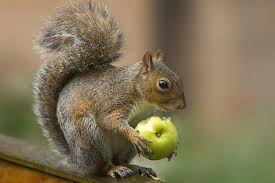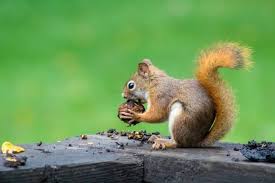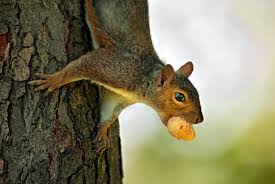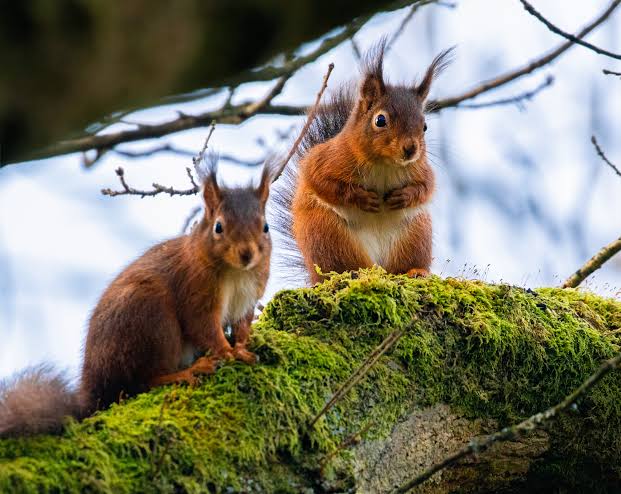Squirrels, scientifically known as Sciuridae, are fascinating creatures that capture the attention of many with their lively antics and bushy tails. These small to medium-sized rodents are found across various parts of the world, inhabiting forests, parks, and urban areas.
With their keen sense of curiosity and agility, squirrels are adept at navigating the treetops and leaping from branch to branch. Their scientific family, Sciuridae, includes a diverse range of species, each with unique characteristics that contribute to their adaptability in different environments.
One of the distinctive features of squirrels is their bushy tails, which serve multiple purposes. These tails help them maintain balance while climbing and act as a communication tool, signaling other squirrels about potential dangers or available food sources. Additionally, squirrels use their tails as a shield against the elements, providing insulation during colder seasons.
Squirrels are primarily herbivores, with a diet consisting of nuts, seeds, fruits, and even fungi. Their front teeth, which continuously grow, allow them to gnaw on hard surfaces like nuts, aiding in their foraging habits. These rodents are known for their hoarding behavior, collecting and burying food to sustain them during periods of scarcity.
The reproductive habits of squirrels vary among species, but generally, they give birth to multiple offspring in a single litter. Mother squirrels demonstrate remarkable care for their young, nurturing and protecting them until they are ready to venture out on their own.
The adaptability of squirrels is evident in their ability to thrive in urban environments. They often coexist with humans, utilizing trees and structures as makeshift homes. However, this proximity can sometimes lead to conflicts, as squirrels may raid bird feeders or chew on electrical wires.
Despite their sometimes pesky behaviors, squirrels play a crucial role in ecosystems. They contribute to seed dispersal, helping to regenerate forests by burying and forgetting about seeds, allowing new plants to grow. Additionally, they serve as prey for various predators, contributing to the intricate balance of wildlife.
However, squirrels, or members of the Sciuridae family, are remarkable creatures with a multitude of intriguing traits. From their agile tree-climbing abilities to their unique communication through tail movements, these rodents have carved out a niche in ecosystems worldwide. As we observe these small, furry beings, it becomes evident that their existence is intertwined with the delicate balance of nature.
Read Also: Swine Processing and Marketing
Pants Affected by Squirrels

Squirrels, in their quest for food and shelter, can have an impact on various plants. These bushy-tailed rodents interact with plants in different ways, sometimes to the detriment of gardeners and homeowners.
1. Bulbs and Flowers: Squirrels are notorious for digging up and munching on flower bulbs. Spring-blooming bulbs like tulips and crocuses may fall victim to squirrels, as these rodents have a keen sense of smell and can locate buried bulbs easily. This behavior can be frustrating for gardeners who invest time and effort in planting bulbs for a vibrant spring display.
2. Fruits and Berries: Squirrels are opportunistic feeders and may target fruit-bearing trees, such as apple, cherry, and peach trees. They can damage fruits and eat berries, impacting the yield of fruit-bearing plants. This can be a particular concern for orchard owners and those who cultivate berry bushes.
3. Seedlings and Sprouts: Gardeners starting plants from seeds may encounter challenges, as squirrels might unearth and nibble on emerging seedlings. This behavior can hinder the success of gardening efforts, especially for those growing vegetables or flowers from seeds.
4. Bark Stripping: Squirrels may strip the bark off trees, particularly in winter. This behavior can harm the trees by exposing them to diseases and pests. Young trees are particularly vulnerable, and repeated stripping can impede their growth and development.
5. Nesting Materials: Squirrels often use plant materials for constructing their nests. They may strip leaves, twigs, and bark from trees and shrubs, which can affect the overall health and appearance of the plants. This nesting behavior is a natural instinct for squirrels but can be a concern for landscaped areas.
While the impact of squirrels on plants can be frustrating, there are ways to mitigate their influence. Protective measures, such as using physical barriers, repellents, or planting squirrel-resistant species, can help minimize damage. Understanding the habits of squirrels and implementing appropriate strategies allows for a more harmonious coexistence between these rodents and the plants they interact with.
Damages Caused by Squirrels

Squirrels, while charming with their playful antics, can inadvertently cause various damages, especially when they come into close proximity with human environments. Here are some of the common issues associated with squirrel activities:
1. Garden and Landscape Damage: Squirrels are notorious for their digging behavior, which can wreak havoc on gardens. They may uproot plants, disturb soil, and dig holes in search of buried nuts or to create hiding spots for their food caches. This can be frustrating for gardeners striving to maintain a well-kept outdoor space.
2. Property Chewing: Squirrels have strong teeth that continuously grow, leading them to chew on various objects to keep their teeth at a manageable length. Unfortunately, this behavior may extend to structures like wooden decks, siding, and even electrical wires. Gnawing on these items can result in structural damage or pose a fire hazard in the case of electrical wires.
3. Bird Feeder Raids: Bird feeders are attractive targets for squirrels seeking an easy meal. These nimble creatures can jump onto feeders, spilling seeds and deterring birds from accessing the food. The persistent efforts of squirrels to raid bird feeders can be a source of frustration for bird enthusiasts.
4. Attic and Nesting Intrusions: Squirrels are skilled climbers and may find their way into attics or crawl spaces to create nests. Once inside, they can cause damage by chewing on insulation, wood, and electrical wiring. This behavior not only poses a threat to the structural integrity of homes but also increases the risk of electrical fires.
5. Crop and Fruit Damage: In agricultural settings, squirrels can cause damage to crops, especially fruits and nuts. Orchards and fields with nut-bearing trees may experience reduced yields due to squirrels feeding on or damaging the developing fruits and nuts.
6. Interference with Bird Nests: Squirrels are known to raid bird nests for eggs and nestlings. This can have a detrimental impact on local bird populations, affecting the breeding success of various bird species.
While squirrels play an essential role in ecosystems, their activities can sometimes lead to challenges for humans. Implementing preventive measures, such as securing potential entry points, using deterrents, and employing squirrel-resistant bird feeders, can help minimize the damages caused by these resourceful rodents.
Read Also: Uses of Pig Meat and Pig Marketing
Control and Preventive Measures

Implementing effective control and preventive measures is crucial to managing squirrel-related issues. Here are some practical strategies to minimize the impact of squirrels in various settings:
1. Physical Barriers: Install barriers such as metal mesh or hardware cloth around garden beds, bulbs, and the base of trees to prevent squirrels from digging or accessing plants. Use metal baffles on bird feeder poles to deter squirrels from reaching the feeders.
2. Squirrel-Resistant Bird Feeders: Invest in bird feeders specifically designed to be squirrel-resistant. These feeders often feature mechanisms that close access to food when a squirrel’s weight is detected, allowing birds to feed without interference.
3. Repellents: Use commercial repellents designed to deter squirrels. These can come in the form of sprays, granules, or electronic devices emitting ultrasonic sounds. Ensure the chosen repellent is safe for plants, pets, and the environment.
4. Trimming Tree Branches: Trim branches that overhang buildings or structures to limit squirrel access to roofs and attics. This reduces the chances of them gaining entry into homes and causing damage.
5. Secure Attic Entry Points: Seal potential entry points into attics and crawl spaces with durable materials like metal flashing or mesh. Inspect and repair any existing damage to prevent squirrels from nesting in these spaces.
6. Habitat Modification: Make the environment less attractive to squirrels by reducing potential food sources. Harvest fruits and nuts promptly, and keep outdoor areas clean to discourage foraging.
7. Use Squirrel-Proof Plant Varieties: Choose plant varieties that are less appealing to squirrels. While no plant is entirely squirrel-proof, some species are less likely to attract their attention.
8. Employ Traps: In cases where local regulations permit, humane traps can be used to capture and relocate squirrels. Ensure you follow legal and ethical guidelines for trapping and relocating wildlife.
9. Professional Assistance: If squirrel issues persist or are causing significant damage, consider seeking professional assistance. Wildlife control experts can provide tailored solutions and ensure humane removal methods.
Balancing coexistence with wildlife and protecting property requires a combination of these measures. By employing a proactive approach and considering the specific challenges in your environment, you can create a more harmonious relationship with the squirrels in your vicinity.
Frequently Asked Questions (FAQs) About Squirrels (Sciuridae)
1. Q: What is the scientific name for squirrels?
A: Squirrels belong to the family Sciuridae, and their scientific name varies by species. For instance, the Eastern Gray Squirrel is known as Sciurus carolinensis.
2. Q: Do all squirrels hibernate during winter?
A: No, not all squirrels hibernate. While some species, like ground squirrels, may enter a state of torpor during winter, tree-dwelling squirrels remain active throughout the year, relying on food stores to survive colder months.
3. Q: Why do squirrels bury nuts?
A: Squirrels bury nuts as a way of storing food for future consumption. This behavior helps them survive periods of scarcity when food sources may be limited. Interestingly, squirrels don’t always remember where they buried each nut, contributing unintentionally to seed dispersal.
4. Q: How can I prevent squirrels from raiding my bird feeders?
A: Use squirrel-resistant bird feeders with mechanisms that close access when a squirrel’s weight is detected. Additionally, place feeders away from jumping points and use baffles on poles to deter climbing.
5. Q: Do squirrels pose any health risks to humans?
A: Generally, squirrels do not pose significant health risks to humans. However, they can carry diseases like leptospirosis. It’s advisable to avoid direct contact with squirrels and their feces.
6. Q: Can I relocate squirrels if they become a nuisance?
A: Before relocating squirrels, check local regulations, as it may be illegal in some areas. If relocation is allowed, use humane traps, and release them in a suitable habitat far from human settlements.
7. Q: How do I protect my garden from squirrel damage?
A: Implement physical barriers like metal mesh around garden beds, use squirrel-resistant bird feeders, and consider planting species less attractive to squirrels. Trimming overhanging branches can also help deter them.
8. Q: Do squirrels have predators?
A: Yes, squirrels have various natural predators, including birds of prey, snakes, and mammalian predators like foxes and domestic pets. These predators play a role in maintaining a balanced ecosystem.
9. Q: Are all squirrels the same?
A: No, there are over 200 different species of squirrels, and they exhibit a wide range of sizes, colors, and behaviors. Tree squirrels, ground squirrels, and flying squirrels are among the diverse types.
10. Q: Can squirrels be kept as pets?
A: In many places, keeping squirrels as pets is not recommended or legal. Squirrels have specific dietary and environmental needs that can be challenging to meet in captivity, and they are best left in their natural habitat.
Read Also: How to Become a Teacher

